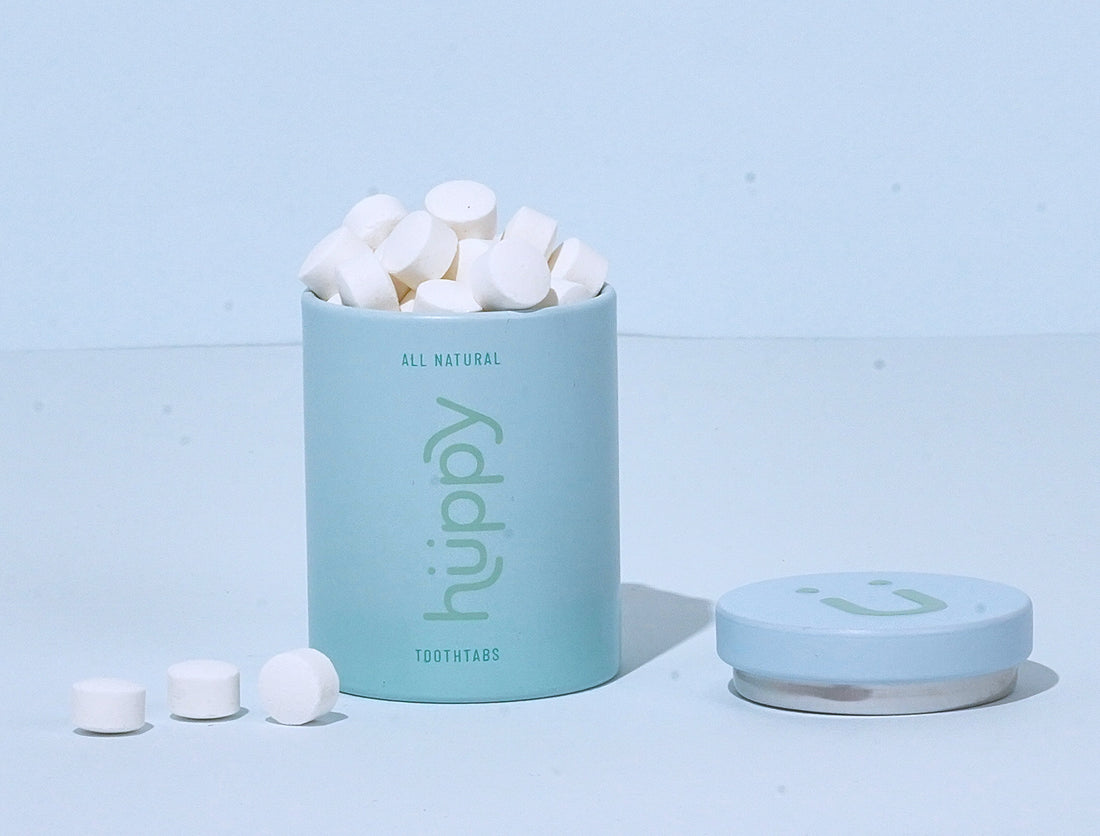
Looking For A Fluoride Substitute? Nano-Hydroxyapatite Is A Toothpaste Game-Changer
Imagine a healthy, white smile, fresh breath, and advanced cavity protection, all packaged in reusable and compostable containers. The star ingredient in our toothpaste tablets is nano-hydroxyapatite, the latest innovation in the world of dental hygiene. Iit offers the benefits of fluoride without the risks or toxicity complications.
We only get one set of permanent teeth to last our lifetime, and taking care of them with sound dental hygiene practices is our first line of defense against cavities. At Huppy, we believe prevention is better than cure and we’ve developed our toothpaste tablets to be sustainable and packed full of goodness: for you, your family, and the planet.
One of the signature ingredients in our toothpaste formulation is nano-hydroxyapatite, a biomimetic alternative to fluoride. NASA introduced nano-hydroxyapatite in the 1970s but it took over 30 years before it was included in commercially available toothpastes. If you haven’t heard about it before, you’re not alone. This article will explain why it’s so helpful in oral care and why you should consider including it in your dental hygiene routine.
If you’re searching for a safe fluoride alternative, keep reading to discover how nano-hydroxyapatite could refresh your oral care.
The Case For Keeping Your Teeth Clean
You may not know, but humans started using toothpaste as far back as 5000 BC and it evolved with us. Believe it or not: toothpaste has been around for longer than the toothbrush, and the first toothpaste was abrasive in texture.
Despite humanity’s long relationship with dental care, the World Health Organization says tooth decay is the most prevalent chronic disease globally. The American Dental Association estimates that over 26% of the adult population suffers from untreated tooth decay. For many years fluoride has been credited for preventing dental decay. Because of the risk of fluorosis in children, a great deal of research has gone into hydroxyapatite and its ability to protect teeth without introducing toxic additives.
So What Makes A “Good” Toothpaste?
Toothpaste should promote remineralization and protect against demineralization of tooth enamel to promote sound oral hygiene.
“Demineralization” is the loss of phosphate and calcium ions in your teeth. This process weakens your dental enamel and makes you more susceptible to decay. It occurs when the bacteria in your mouth create an environment that is too acidic. “Remineralization” is the addition of phosphate and calcium into the enamel from your saliva, which strengthens and protects your teeth.
We should all brush and floss twice a day to
- Clean and polish our teeth
- Remove plaque
- Remove stains
- Protect our teeth against decay and ultimately, against tooth loss
- Freshen breath
- Protect us against gum inflammation and gum disease
You may have been using a particular toothpaste brand because of its marketing or because it’s what your parents introduced you to when you first started looking after your teeth. You may take it for granted that the ingredients that compose your toothpaste achieve all of the dental hygiene benefits listed above. Humans have discovered that adding fluoride to drinking water is a step forward in the fight against tooth decay, but we also know that it’s a neurotoxin and consuming too much can cause adverse effects.
Why Nano-Hydroxyapatite Is A Toothpaste Game-Changer
Dental enamel is the hardest substance in the human body. It forms the outermost layer of your teeth. Its role is to protect the softer layers - the dentin and pulp. About 96% of dental enamel is comprised of hydroxyapatite (HA), as well as smaller quantities of sodium, fluoride, magnesium, carbonate, and water. Hydroxyapatite also makes up around 70% of the dentin under your enamel.
The condition and appearance of your dental enamel can give you white, healthy-looking teeth. The hydroxyapatite in dental enamel closes the tiny pores in the surface of your teeth, giving added protection against tooth decay.
Hydroxyapatite vs Nano-hydroxyapatite
Hydroxyapatite is an essential contributor to the strength of your teeth. Your saliva also contains hydroxyapatite. This remineralizes and repairs your dental enamel. Hydroxyapatite is referred to as “bioavailable” calcium (meaning that it is compatible with living tissue). We need calcium to strengthen our enamel (and our bones).
What Is Nano-Hydroxyapatite?
Nano-hydroxyapatite is a synthetic version of hydroxyapatite, and its inclusion in medicine started with NASA. When astronauts are in microgravity, they lose bone mass, as bones are not subjected to the same stress in space as they are on Earth. NASA started researching ways to remineralize bones and teeth and developed the first hydroxyapatite gel back in 1974. The United States introduced the first nano-hydroxyapatite toothpaste in 2017.
By the way, nano-hydroxyapatite bonds chemically with bone without introducing inflammation or toxicity. It is used extensively in oral maxillofacial surgery and periodontology. Nano-hydroxyapatite has been used in implantology for many years because it encourages good bone-implant integration.
The Importance Of Nano-Hydroxyapatite For Strengthening Tooth Enamel
When you understand how dental enamel is constructed (and eroded during the process of tooth decay) you can appreciate the benefits of nano-hydroxyapatite for your long-term dental health.
In healthy teeth, there is a balance between the hydroxyapatite minerals of the tooth and saliva. Remember that we explained how “demineralization” is the loss of phosphate and calcium ions from your teeth, and “remineralization” is the addition of phosphate and calcium into the enamel from your saliva? Scientific research has shown that a prohibitive factor in enamel remineralization is the availability of phosphate and calcium - you need a certain amount of phosphate and calcium to repair your dental enamel. Very significantly, the primary ingredients in nano-hydroxyapatite toothpaste are phosphate and calcium.
Hydroxyapatite particles bind with damaged tooth enamel, filling in surface irregularities and repairing the damage. And, while fluoride only assists with surface remineralization, hydroxyapatite can penetrate at a deeper level.
The Benefits Of Nano-Hydroxyapatite Toothpaste Tablets
Here are some of the reasons nano-hydroxyapatite is such a crucial ingredient in Huppy toothpaste tablets
1. Nano-Hydroxyapatite Offers Advantages Over Fluoride
Fluoride is naturally occurring and has been used in toothpaste since 1955 to protect teeth against decay. However, the quantities of fluoride in toothpaste aren’t as beneficial as the amount in the water used to brush your teeth. Adding fluoride to water has reduced dental decay by 20 to 40% in adults and children. Fluoride is also used as a treatment to protect against tooth decay.
Fluoride is less abundant in phosphate and calcium. These are two crucial components of hydroxyapatite required for repairing dental enamel. Nano-hydroxyapatite also has high biocompatibility making it ideal for children who can’t spit their toothpaste out after brushing.
What Are The Differences Between Hydroxyapatite And Fluoride?
Hydroxyapatite protects the teeth by creating a layer of synthetic enamel around them. Fluoride hardens the existing enamel by inducing a chemical change. The nano-hydroxyapatite coating provides more effective protection than fluorapatite.
The Disadvantages Of Fluoride
Too much fluoride can lead to dental fluorosis or skeletal fluorosis, which can cause damage to teeth, bones, and joints. Excessive amounts of fluoride can cause white specks or streaks on your tooth enamel. Dental fluorosis usually happens in younger children when their teeth are still developing below their gums. While it might not cause damage to the tooth structure initially, the discoloration can be visible. Mild fluorosis can cause discoloration of the teeth, but more severe forms of fluorosis can cause damage.
Pro Tip:
Children under the age of six should use fluoride-free mouthwash and toothpaste. Supervise young children so they do not swallow their toothpaste. Unfortunately more than 80% of fluoride poisonings take place in children under the age of six, because they swallow their toothpaste. It’s also one of the primary reasons that parents are advised only to use a rice-shaped amount of fluoridated toothpaste when young children are learning to brush. Of course, it’s another reason we developed Huppy toothpaste tablets to be fluoride-free - you don’t have to worry about your child swallowing it accidentally.
2. Nano-Hydroxyapatite Has Advanced Repair Properties
When nano-hydroxyapatite is included in toothpaste, it binds with bacteria and plaque, removing it quickly and easily. It also performs a “filler” function by repairing holes in the surface of dental enamel, thanks to its small particle size, which we’ve explained above.
Pro Tip:
Don’t rinse your mouth after brushing with nano-hydroxyapatite toothpaste tablets. This leaves a protective layer around your teeth and gives the toothpaste the best chance of remineralizing any damaged tooth enamel.
3. Nano-Hydroxyapatite Has Shown “Good Results” For Tooth Sensitivity
If you suffer from tooth sensitivity, nano-hydroxyapatite could bring you almost-instant relief. Dentin hypersensitivity is sharp, short bursts of pain in the teeth that is triggered by various factors
- Sugar
- Air
- Contact (touching the teeth)
- Hot or cold temperatures
One clinical study published in 2015 found that brushing twice a day with a toothpaste containing nano-hydroxyapatite resulted in
- 52-76% improvement in tooth sensitivity in 48 hours
- 70-84% improvement in tooth sensitivity after two weeks.
4. Nano-Hydroxyapatite Has A Whitening Effect
Healthy teeth are essential for your quality of life, but having a white smile also boosts your self-confidence and esthetics. Nano-hydroxyapatite has been found to have a whitening effect on teeth without using bleaches or abrasives.
What Are The Benefits Of Toothpaste Tablets?
If you’ve been using squeezable toothpaste for most of your life, you might wonder what the big deal about toothpaste tablets is.
Waste Reduction: Better For The Planet, Better For You
Squeezable toothpaste was introduced to the world in the 1880s, making dental hygiene easier for the average person. On the flip side, however, it also introduced a lot of unnecessary plastic waste through disposable packaging, which ends up in our oceans. Every year, billions of disposable toothpaste tubes enter oceans and landfills.
How Do You Use Toothpaste Tablets?
The good news is that Huppy toothpaste tablets are easy to use:
- Place one tablet in your mouth
- Chew the tablet so it mixes with your saliva
- Use your toothbrush to brush for two minutes
- Do not rinse your mouth with water
- Repeat this twice a day
- Don’t forget to floss!
What Are The Advantages Of Huppy Toothpaste Tablets With Nano-Hydroxyapatite?
Our toothpaste tablets undergo continuous improvements to develop a product that tastes great, freshens breath, and is kinder to the environment. Most current toothpaste tablets leave a chalky aftertaste or mouthfeel, and many natural kinds of toothpaste don’t generate a satisfying foam that makes your mouth feel clean.
Our packaging is reusable and our refills are compostable, which means we don’t contribute to the plastic problem in our oceans and landfills. Our products are conveniently packaged according to the number of people in your household, so you can place repeat subscription orders every 4 month and have them delivered straight to your door.
Plus, we’ve developed an entire range of oral care products
Huppy products are available in refreshing flavors like peppermint, charcoal mint, and watermelon strawberry. Plus, they are all available in travel sizes too. Now that’s something to smile about.
Curious about replacing the fluoride in your toothpaste with a biocompatible ingredient like nano-hydroxyapatite? Be Huppy!

